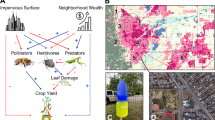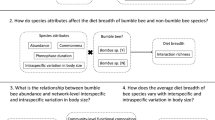Abstract
The present study discusses spatial variations in the community structure of stingless bees as well as associated ecological factors by comparing the nest densities in two stages of forest regeneration in a Brazilian Tropical Atlantic rainforest. The stingless bee nests were sampled in sixty-four 25 × 25 m plots (4 ha) in four replicates of two forest categories: (a) mature, or old growth, stage of forest regeneration and (b) early-stage forest regeneration. Tree cavities were the major nesting substrate, and 91 nests were found within the total sampling area of 32 ha (2.8 nests/ha), constructed by 12 stingless bee species. The four most abundant species showed no significant differences in terms their use of tree circumference at breast height (CBH) categories between 60 and 150 cm. The spatial distributions of the CBH categories were mainly random or uniform, and the principal difference between the forest stages was the density of their largest trees (CBH >110 cm). This structural difference in the vegetation contrasted with the small spatial variation (p > 0.05) of the stingless bee community structure (species composition, richness, and nest abundance). This unexpected spatial homogeneity could be related to similar and abundant availabilities of the largest nesting sites and to the existence of similar mechanisms controlling cavity use in both forest categories. The low nest-per-tree frequency (1 nest per 100 trees with CBH >60 cm), for instance, suggests that the availability of tree nesting sites is not limiting stingless bees. Alternatively, the stochasticity that permeates the temporal dynamics of highly diverse tree communities may also neutralize any latent competition between stingless bees.




Similar content being viewed by others
References
Adams, J. (2009) Species Richness: Patterns in the Diversity of Life. Praxis, Chichester. 396 p
Anderson, M.J. (2005) Permanova: Permutational Multivariate Analysis of Variance—A Computer Program. Department of Statistics, University of Auckland, New Zealand
Batista, M.A., Ramalho, M., Soares, A.E.E. (2003) Nesting sites and abundance of Meliponini (Hymenoptera: Apidae) in heterogeneous habitats of the Atlantic rain forest, Bahia. Brazil. Lund. 4, 19–23
Biesmeijer, J.C., Slaa, J. (2006) The structure of eusocial bee assemblages in Brazil. Apidologie 37, 240–258
Bray, J.R., Curtis, J.T. (1957) An ordination of the upland forest communities of southern Wisconsin. Ecol. Monogr. 27, 325–49
Brown, J.C., Albrecht, C. (2001) The effect of tropical deforestation on stingless bees of the genus Melipona (Insecta: Hymenoptera: Apidae: Meliponini) in central Rondonia. Brazil. J. Biogeogr. 28, 623–634
CEI-Conder-Ba (1993) Informações básicas dos municípios baianos: Litoral Sul. Salvador, 1993. v 5. 1100 p.
Chao, A. (2005) Species richness estimation. In: Balakrishnan, N., Read, C.B., Vidakovic, B. (eds.) Encyclopedia of Statistical Sciences, pp. 7909–7916. Wiley, New York
Clark, P.J., Evans, F.C. (1954) Distance to nearest neighbour as a measure of spatial relationships in populations. Ecol. 35, 445–453
Cody, M.L. (1989) Discussion: structure and assembly of communities. In: Roughgarden, J., May, R.M., Levin, S.A. (eds.) Perspectives in Ecological Theory, pp. 203–226. Princeton University Press, New Jersey
Eltz, T., Brühl, C.A., Kaars, S.V., Linsenmair, K.E. (2002) Determinants of stingless bee nest density in lowland dipterocarp forests of Sabah. Malaysia. Oecol. 131, 27–34
Eltz, T., Brühl, C.A., Kaars Imiyabir, Z., Linsenmair, K.E. (2003) Nesting and nest trees of stingless bees (Apidae: Meliponini) in lowland dipterocarp forests in Sabah, Malaysia, with implications for forest management. For. Ecol. Manage. 172, 301–313
Flesher, K.M. (2006). The biogeography of the medium and large mammals in a umandominated landscape in the Atlantic Forest of Bahia, Brazil: evidence for the role of agroforestry systems as wildlife habitat. Doctoral Thesis. Program in Ecology and Evolution. School-New Brunswick Rutgers, The State University of New Jersey. 624 p
GraphPad Software (1998). [computer program] Version 3.05 San Diego (CA): GraphPad Software, Inc
Hubbell, S.P. (2001) The unified neutral theory of biodiversity and biogeography. Princeton University Press, Princeton
Hubbell, S.P., Johnson, L.K. (1977) Competition and nest spacing in a tropical stingless bee community. Ecol. 58, 950–963
Johnson, L.K., Hubbell, S.P. (1974) Aggression and competition among stingless bees: field studies. Ecol. 55, 120–127
Johnson, L.K., Hubbell, S.P. (1975) Contrasting foraging strategies and coexistence of two bee species on a single resource. Ecol. 56, 1398–1406
Johnson, L.K., Hubbell, S.P. (1984). Nest tree selectivity and density of stingless bee colonies in a Panamanian forest. In: Chadwick, A.C. and Sutton L. (eds). Tropical rain forest: the Leeds Philosophical Symposium, pp. 147–154.
Johnson, L.K., Hubbell, S.P., Feener, D.H. (1987) Defense of food supply by eusocial colonies. Americ. Zool. 27, 347–358
Kenney, A.J., Krebs, C.J. (2000) Programs for Ecological Methodology, 2nd edn. Department of Zoology University of British Columbia, Vancouver
Kleinert, A.M.P. (2006). Demografia de ninhos de meliponíneos em biomas neotropicais. Tese (Livre Docência). Universidade de São Paulo. São Paulo, SP. 93p
Kleinert, A.M.P., Ramalho, M., Laurino, M.C., Ribeiro, M.F., Impetratriz-Fonseca, V.L. (2012) Social bees (Meliponini, Apinini, Bombini). In: Panizzi, A.R., Parra, J.R.P. (eds.) Insect Bioecology and Nutrition for Integrated Pest Management, pp. 237–271. CRC, Boca Raton
Köppen, W. (1948) Climatologia: con un estudio de los climas de la terra, p. 479p. Fondo Cult. Econ, México
McCune, B., Grace, J.B. (2002) Distance measures. In: Mc-Cune, B., Grace, J.B. (eds.) Analysis of Ecological Communities. MjM Software Design, Gleneden Beach. Chapter 6
Michener, C.D. (2000) The Bees of the World. Johns Hopkins University, Baltimore. 913p
Nogueira-Neto, P. (1970) A criação de abelhas indígenas sem ferrão. Editora Chácaras e Quintais, São Paulo. 365p
Nogueira-Neto, P. (1997) Vida e criação de abelhas indígenas sem ferrão, p. 445p. Nogueirapis, São Paulo
Oliveira, M.L., Morato, E.F., Garcia, M.V.B. (1995) Diversidade de espécies e densidade de ninhos de abelhas sociais sem ferrão (Hymenoptera, Apidae, Meliponinie) em floresta de terra firme na Amazônia Central. Rev. Bras. Zool. 12(1), 13–24
R Development Core Team (2011). R: a language and environment for statistical computing. R Foundation for Statistical Computing, Vienna, Austria. ISBN 3-900051-07-0, URL http://www.R-project.org/.
Ramalho, M. (1990) Foraging by stingless bees of the genus Scaptotrigona (Apidae, Meliponinae). J. Apic. Res. 29, 61–67
Ramalho, M. (2004) Stingless bees and mass flowering trees in the canopy of Atlantic Forest: a tight relationship. Acta. Bot. Bras. 18(1), 37–47
Ramalho, M., Silva, M.D., Carvalho, C.A.L. (2007) Dinâmica de uso de fontes de pólen por Melipona scutellaris Latreille (Hymenoptera, Apidae): Uma Análise Comparativa com Apis mellifera L. (Hymenoptera, Apidae), no Domínio Tropical Atlântico. Neotropical Entomology 36, 38–45
Roubik, D.W. (1979) Nest and colony characteristics of stingless bees from French Guianas (Hymenoptera: Apidae). J. Kansas Entomol. Soc. 52, 443–470
Roubik, D.W. (1983) Nest and colony characteristics of stingless bees from Panama (Hymenoptera: Apidae). J. Kansas Entomol. Soc. 56, 327–355
Roubik, D.M. (1989) Ecology and Natural History of Tropical Bees. Cambridge University Press, London. 514p
Roubik, D.W. (1993) Direct costs of forest reproduction, bee-cycling and the efficiency of pollination modes. Journal of Biosciences 18, 537–552
Roubik, D.M. (2006) Stingless bees nesting biology. Apidologie 37, 124–143
Roughgarden, J. (1989) The structure and assembly of communities. In: Roughgarden, J., May, R.M., Levin, S.A. (eds.) Perspectives in Ecological Theory, pp. 203–226. Princeton University Press, Princeton
Slaa, E.J. (2006) Population dynamics of a stingless bee community in the seasonal dry lowlands of Costa Rica. Ins. Soc. 53, 70–79
Sutherland, W.J. (1996) Ecological Census Techniques. Cambridge University Press, Cambridge
Vergara, C.B., Villa, A.L., Nates-Parra, G. (1986) Nidificación de meliponinos (Hymenoptera: Apidae) de la región central de Colombia. Rev. Bio. Trop. 34, 181–184
Acknowledgments
We are grateful to Michelin for logistic support, CAPES for providing the doctoral grant to the first author, as well as CNPq (process numbers 481113/2004-5 and 478271/2008) and FAPESB (APR0114/2006) for financial support. We also thank the ECOPOL team at UFBA for their help with the fieldwork.
Author information
Authors and Affiliations
Corresponding author
Additional information
Manuscript editor: James Nieh
Diversité et utilisation de l’habitat par les abeilles sans aiguillon (Apidae) dans la forêt Atlantique brésilienne
Meliponini / site de nidification / arbre / densité
Diversität und Habitatnutzung bei stachellosen Bienen (Apidae) des brasilianischen atlantischen Waldes
Meliponini / Nistplätze / Baumsubstrate
Rights and permissions
About this article
Cite this article
Silva, M.D.E., Ramalho, M. & Monteiro, D. Diversity and habitat use by stingless bees (Apidae) in the Brazilian Atlantic Forest. Apidologie 44, 699–707 (2013). https://doi.org/10.1007/s13592-013-0218-5
Received:
Revised:
Accepted:
Published:
Issue Date:
DOI: https://doi.org/10.1007/s13592-013-0218-5




